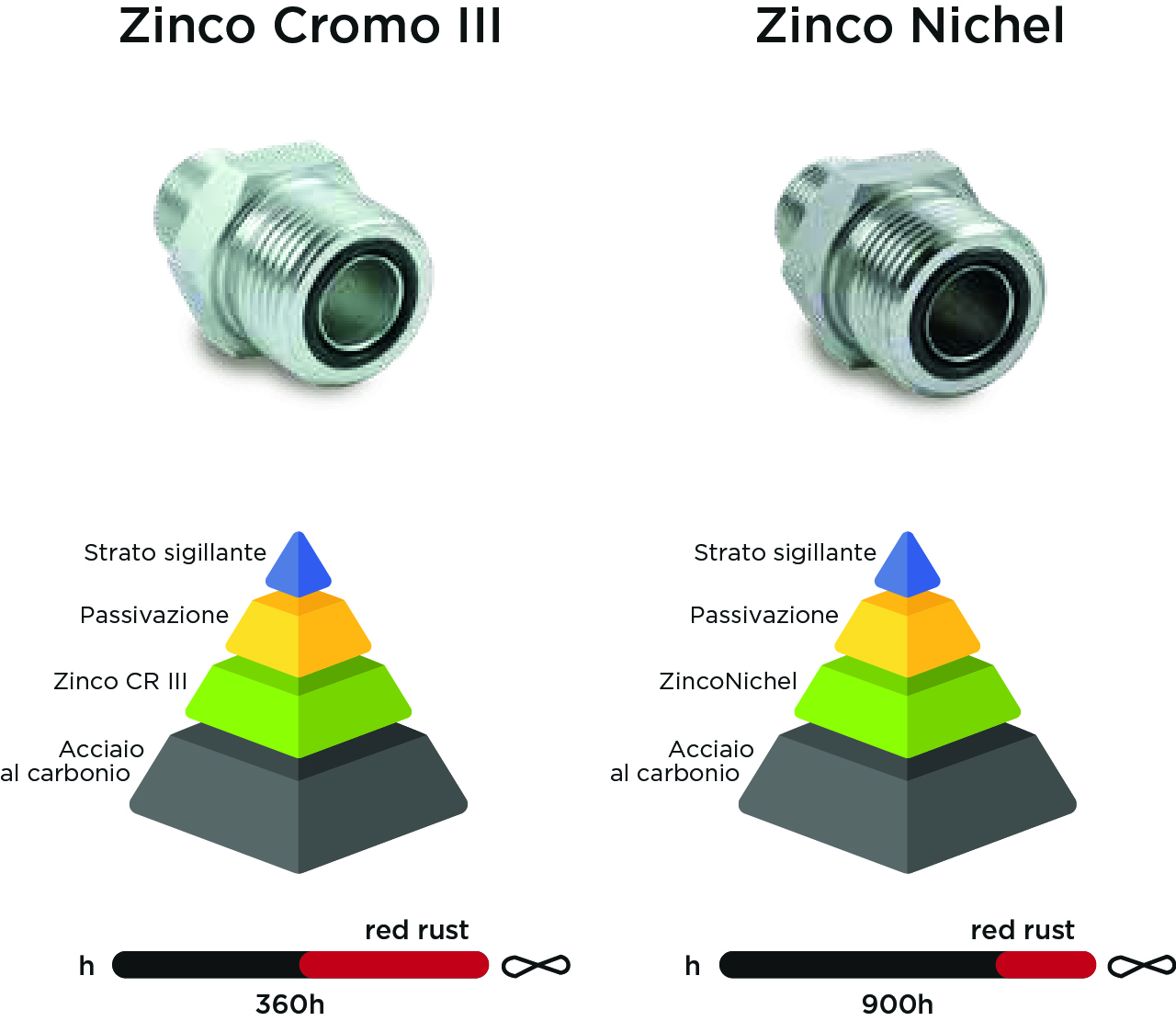Do you not have the Username and Password to access the Order Area?
Do you wish to place an order?
Zinc-nickel plating is an advanced surface treatment that provides excellent protection against corrosion and wear. Widely used across various industrial sectors, this process is an effective solution to enhance the strength and durability of metal components. In this article, we’ll explore the key features of zinc-nickel, its benefits, and its main fields of application.
Note: Foscarin Group does not provide third-party zinc-nickel plating services, but offers components (such as fittings and adapters) that have already undergone this high-quality treatment, ensuring maximum performance and corrosion resistance.
Zinc-nickel plating is an electrochemical treatment that involves depositing a zinc-nickel alloy onto metal surfaces. This coating offers superior protection compared to traditional Zinc Chromium III plating.
Corrosion is a natural process that causes metal to degrade over time. Zinc-nickel plating helps minimize this effect thanks to its high resistance. There are two main types of corrosion:
White corrosion: Oxidation of the zinc layer on the metal surface.
The negative effects of corrosion include:
Compromised integrity of fluid transport systems
Safety risks and system failures
High maintenance costs and downtime
Premature component replacement
Reduced operational efficiency and reliability
Deteriorated product appearance
Zinc-nickel plating offers several benefits that make it ideal for a wide range of applications. Here are the main advantages:
Corrosion Resistance
Zinc-nickel coating provides significantly better protection than standard zinc plating. Salt spray testing shows that zinc-nickel can withstand up to 900 hours of red corrosion resistance compared to 360 hours for Zinc Chromium III. The presence of nickel enhances resistance to corrosive agents, extending the service life of metal parts even in harsh environments.
High Hardness and Wear Resistance
The zinc-nickel alloy increases surface hardness, reducing wear and improving resistance to abrasion. This makes it especially suitable for mechanical and industrial applications.
Extended Coating Lifespan
Adding a sealing layer after zinc-nickel plating further boosts corrosion resistance, with salt spray resistance ranging from 48 to 96 hours.
High Temperature Resistance
Unlike other surface treatments, zinc-nickel plating retains its properties at high temperatures, making it ideal for applications in thermally demanding environments.

The zinc-nickel plating process is an electrolytic treatment that requires precision and control at every step. Here’s how it works:
Surface Preparation: The metal part is carefully cleaned and degreased to remove impurities, oils, and oxides that could interfere with coating adhesion.
Pre-Treatment: Acid pickling or sandblasting is applied to ensure a receptive surface.
Electrolytic Deposition: The part is submerged in an electrolytic bath containing zinc and nickel salts. Through the application of electric current, a uniform zinc-nickel alloy layer forms on the metal surface. The nickel content (typically between 12% and 16%) is precisely controlled to ensure optimal properties.
Passivation: After plating, a passivation treatment is applied to further enhance corrosion resistance.
The complete process ensures a uniform coating thickness, typically between 6 and 10 µm.
Thanks to its versatility and effectiveness, zinc-nickel plating is used in numerous industries. Here are the main sectors where this treatment is applied:
Agricultural machinery operates in harsh environments with exposure to moisture and chemicals. Zinc-nickel treatment protects metal surfaces, extending component lifespan.
Construction equipment faces extreme working conditions. Zinc-nickel provides advanced protection, extending the life of critical parts like bolts and mechanical joints.
Machinery used in mining operates in highly abrasive environments. Zinc-nickel reduces wear and corrosion, improving equipment reliability.
The marine environment poses a high risk of corrosion due to salt exposure. Zinc-nickel shields components from marine corrosion, increasing their durability.
From industrial vehicles to railway systems, zinc-nickel offers long-term protection against corrosion and mechanical damage.
This treatment is widely used to protect components in industrial production, reducing maintenance costs and enhancing equipment reliability.
Zinc-nickel plating is one of the main reasons why our press fittings and adapters deliver superior performance in terms of durability and resistance.
We have a complete catalogue of components already treated with zinc-nickel plating, ideal for applications in high-demand industrial sectors.
To learn more about the process and its applications, consult the full document available in the Technical Documents section.
Fill out our contact form to receive a personalized consultation and discover the zinc-nickel plated components best suited to your needs.